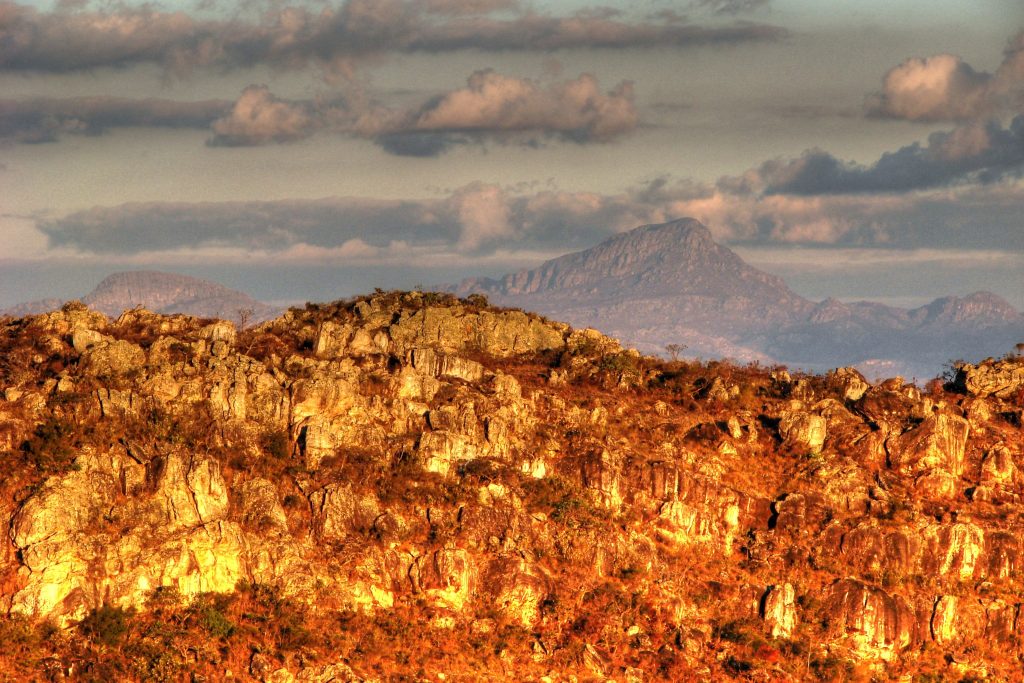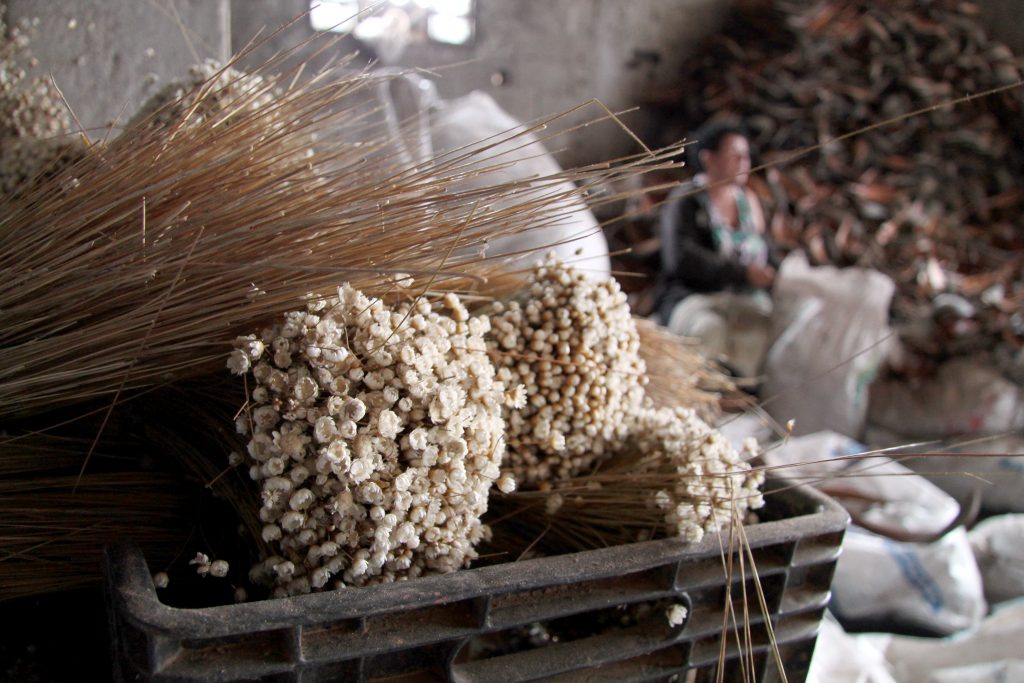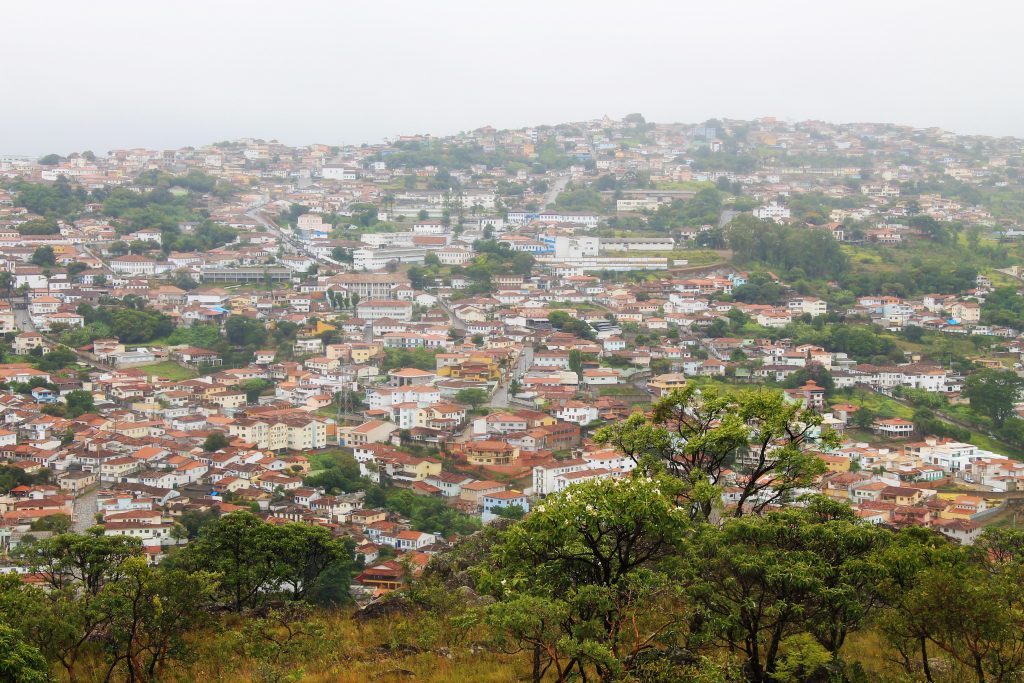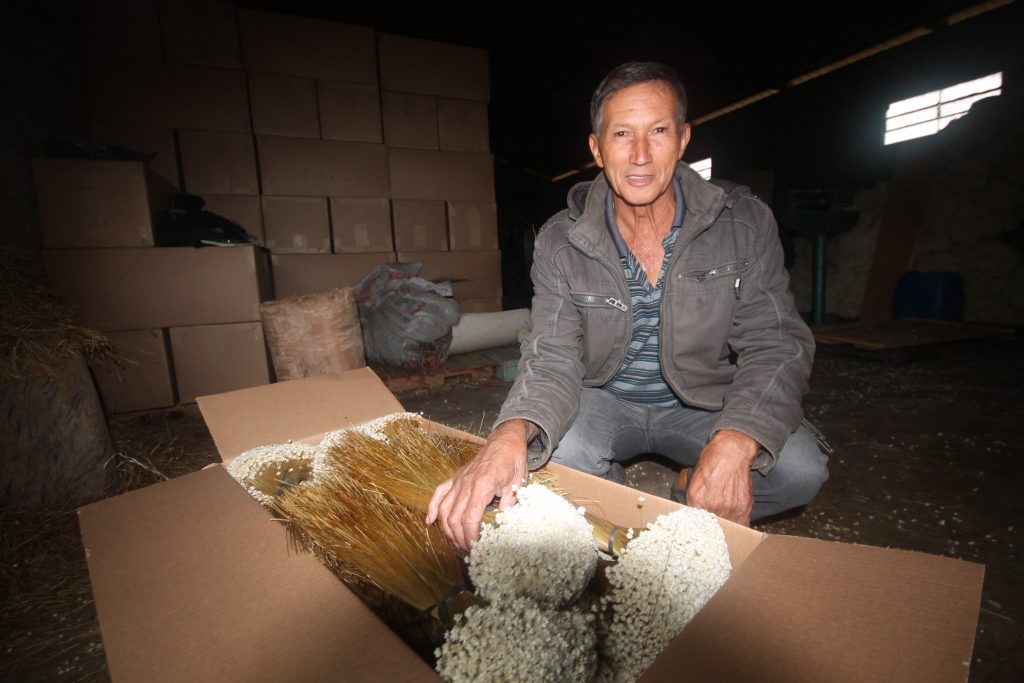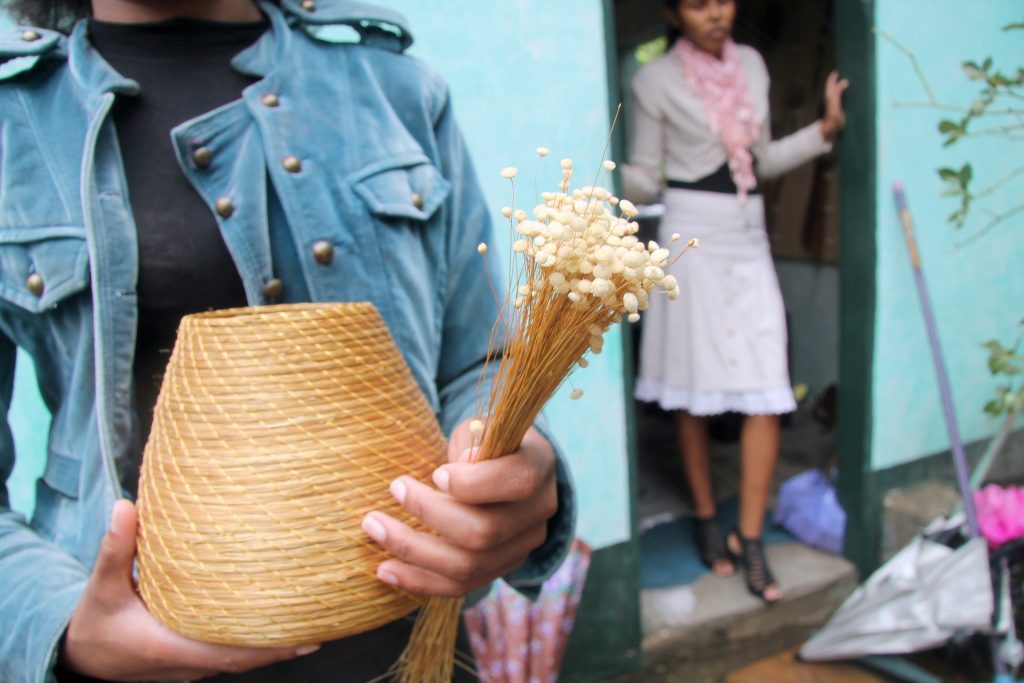A Flower and a Way of Life in Peril
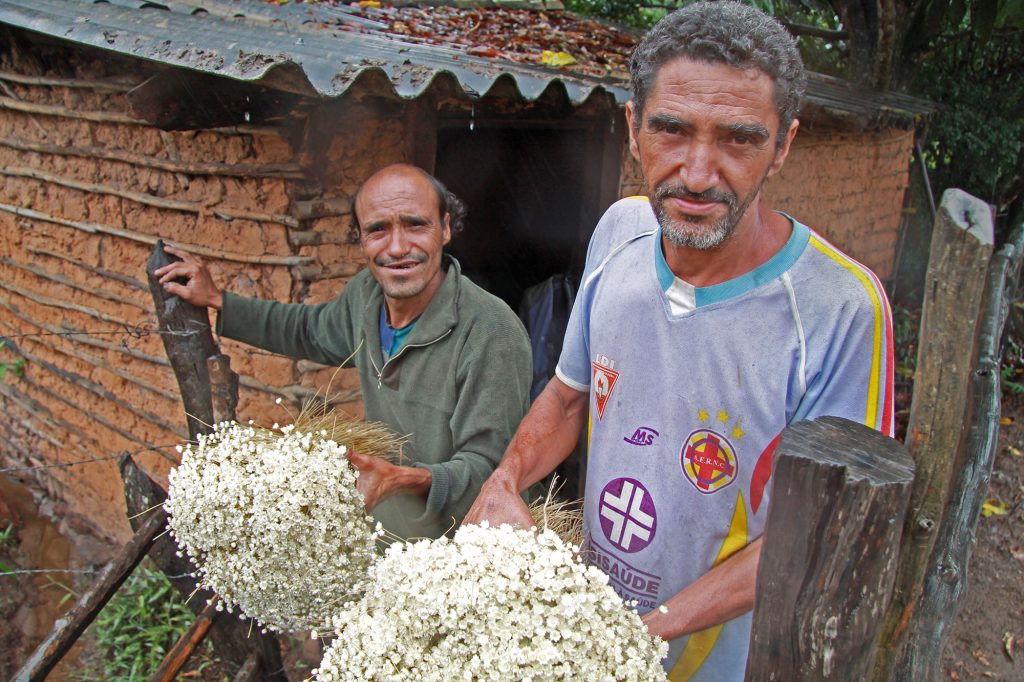
The 680-mile-long Serra do Espinhaço mountain range rises from the Brazilian lowlands like the fossilized backbone of a fallen dinosaur. Sandwiched between the Atlantic rainforest and the country’s savanna heartland, the meadows and scrubby forests that run along this rocky spine are home to tapirs, maned wolves, giant anteaters, and more than 4,000 species of plants.
One of the most alluring and valuable of these plants is a flower found nowhere else on Earth. It has a straw-like stem and a white head the size of a peanut. Lacking the gaudiness of a greenhouse rose or the steamy sensuality of an orchid, these flowers—individually—seem unremarkable. They achieve their beauty through multiplication, when dozens of them are dried and bound into a mesmerizing bouquet in the palette of an eternal autumn. Up to 10 years after their harvest, a drop of water will cause the delicate buds to close their petals. When they dry out again, they open as if they are still alive, which is why this species and its close relatives are called sempre-vivas, Portuguese for “everlasting” flowers.
During the peak flower-collecting season in May and June, the region’s poorest residents migrate to the highlands and bed down in caves or temporary huts in order to collect more than 90 species of flowers in the plant family Eriocaulaceae, which includes sempre-vivas. These range from pé de ouro (golden feet)—one of the most heavily harvested species—to sempre-viva gigante, the largest species, with a head the size of a quarter, which is now so rare that it only occupies a two-square-kilometer plot of land. Flower collectors also harvest other distinctive members of the family, including capim dourado (golden grass), whose long, metallic stems can be used to make glittering handicrafts, such as bowls and purses. Finally, there are the botãos, or “buttons,” that lose their petals when they are dried.
Unfortunately, some of the most popular species are considered threatened or endangered by the International Union for Conservation of Nature (IUCN), a global conservation organization. Furthermore, many prime collecting locales fall inside protected areas—including Sempre-Vivas National Park, which was established to preserve native animals and plants, including sempre-vivas. Over the last decade, the flower collectors have demanded that the park be eliminated, claiming that their livelihoods are at stake, and local politicians and powerful businessmen have co-opted their cause as a means of weakening environmental laws. Today, the mesmerizing flowers have become a potent symbol for a challenge facing Brazilian anthropologists: How can their knowledge of the lives of traditional people—including the migrant flower collectors—be used to help preserve the natural resources these people depend upon? And can a balance be struck between conservation and the economic needs of the people?
“It’s an emblematic case,” notes Fernanda Monteiro, a geographer who is studying the relationship of the flower collectors to the land for her doctorate at the University of São Paulo. In her view, the government has trampled on the rights of the poorest members of society. “For me, as a citizen, it’s been very difficult to watch this happening in Brazil,” she says. One strategy favored by Monteiro and other people working in the region involves transforming Sempre-Vivas National Park into an extractive reserve, a type of protected area that would allow the sustainable harvest of flowers, and, possibly, other uses. Naturally, conservationists remain wary of this idea, considering that only between 2 and 7 percent of the Brazilian savanna, known as the Cerrado, is protected, and it is disappearing at twice the rate of the Amazon.
In February 2015, I traveled to the colonial-era mining town of Diamantina, a UNESCO World Heritage Site high in the Espinhaço Mountains that is now the center of the Brazilian dried-flower business. [1] [1] Reporting for this story was supported by the Mongabay Special Reporting Initiative. The town’s steep, cobbled streets are a labyrinth full of dead ends and tight corners, and it felt especially ominous the night I arrived with rainwater rushing down the unlit alleys. Two days later it was still pouring rain when I hired a guide to take me to the base of a mountain called Serro do Galho.
After a rough drive in his Land Cruiser, we donned our rain gear and followed a wet trail along an escarpment until we descended into a valley to the mud-brick hut where two middle-aged brothers, Antonio and Geraldo da Luz Soares, live. In order to enter their home, we ducked under the rank flesh of a cow udder and other pieces of meat hanging from a clothesline. The brothers offered us their dirt-caked clothes to change into and heated candy-sweet coffee over the open wood fire in back.
Then they proudly showed us their treasure: Six pointillist bouquets of tiny, white flowers tightly bound together with straw. They collect approximately 200 kilograms per year and sell them for $2 to $3 per kilogram. Exporters get three to four times that much when they resell them abroad. All told, dried flower exports from Minas Gerais, one of the largest states in Brazil and the central area for flower collecting, are worth at least $1 million per year, according to a not-yet-published study by Renato Ramos, a botanist who works in the region. When I asked Antonio if the flowers had declined in recent years, he nodded.
“Today, there are fewer flowers,” he said.
“Why?” I asked.
“I don’t know,” he shrugged.
The idea of people living inside a national park and profiting from its biodiversity is at odds with traditional conservation policies. The world’s first national park, Yellowstone, in the western United States, was established in 1872 with the idea that nature could be kept pristine and walled off from human society. “Take only pictures, leave only footprints,” the saying goes. To some extent, this idea is a fallacy made possible by the near-extermination of the Native American people who once lived off the land of the Yellowstone region. But as the idea of national parks and other protected areas for biodiversity spread to other countries, particularly in the developing world, it became clear how arbitrary the concept was. “Untouched nature is a North American idea,” says Monteiro. In Brazil, she says, “When you see some part of the savanna alive, look closely, and you’ll see people.”
As an alternative to strictly protected national parks, extractive reserves have become common in indigenous areas of the Brazilian Amazon but remain relatively rare in other parts of the country. Their history reaches back to the late 1970s, when anthropologist Mary Allegretti was working on her dissertation on the plight of rubber tappers in the Amazon, who were losing their working forests to powerful cattle ranchers. She began working closely with Chico Mendes, a rubber tapper who went on to become one of Brazil’s most famous advocates for indigenous rights. Allegretti and Mendes proposed this new type of conservation area that would—in theory—protect both forest diversity and the livelihoods of indigenous people.
Meanwhile, researchers and community advocates in other parts of Brazil began to realize that conflicts over land and conservation impacted a variety of other local people who led simple lives but were not, strictly speaking, indigenous. In the Vale do Ribeira, a valley that sits between the states of São Paulo and Parana, a network of conservation units was being set up to protect one of the largest contiguous swaths of Atlantic rainforest in Brazil. As a result, local activities such as extraction of forest products and slash-and-burn agriculture—a traditional technique that provides poor tropical soils with a burst of fertility needed to grow small-scale crops that local communities depend on—were limited. Rainforest communities here were made up of mixed populations. Some of the inhabitants were quilombolas, the descendants of freed African slaves who set up so-called quilombos, settlements where they wouldn’t be bothered by the colonizers, beginning in the 1700s. Others were the offspring of white Portuguese colonizers, African Brazilians, and indigenous people who continued to lead their lives as they had for several centuries. Eduardo Brondizio, a Brazilian-born anthropologist now at Indiana University, says that anthropologists gave these people a voice by labeling them “traditional people.” “That idea became an umbrella to empower communities that would otherwise only have informal land rights,” Brondizio says.
After cattle ranchers murdered Mendes in 1988, the Brazilian government responded to the concerns of anthropologists and indigenous rubber tappers by establishing the Chico Mendes Extractive Reserve. Today there are nearly one hundred such reserves in Brazil that preserve standing forests but allow traditional users to harvest forest products, such as rubber or Brazil nuts. In 1994, the International Union for Conservation of Nature gave the concept of extractive reserves its stamp of approval, expanding its protected-area classification system to include “Category VI,” defined as “Protected Areas with Sustainable Use of Natural Resources.” At the time, many prominent conservationists, including John Terborgh of Duke University, a MacArthur fellow who has operated a field station in the Peruvian Amazon since 1973, decried the embrace of such “soft” conservation schemes. Nevertheless, according to the 2014 Protected Planet Report, almost 40 percent of the world’s protected area now falls into Category VI. Some of these areas were created and are managed wholly by local communities, whereas others are managed by governments in cooperation with locals. As a sign of the increasing recognition of the role of local people in conservation success in Brazil, when the country’s environment ministry was reorganized in 2007, the park agency was christened the Chico Mendes Institute for Biodiversity Conservation (ICMBio).
But some scholars and activists find the name a cynical ploy, since it houses the country’s most diehard conservation biologists. (A separate agency, the National Indian Foundation [FUNAI], manages indigenous lands, while the National Institute for Colonization and Agrarian Reform [INCRA] is tasked with sorting out the rights of squatters and traditional people with informal land rights.) When Monteiro was telling me about ICMBio over coffee back at my hotel in Diamantina, she cracked a wry smile and repeated the name again: “Chico Mendes.”
“You think that’s funny?” I asked.
“That is funny,” she laughed. “The institute that received this important name for native people of Brazil created Sempre-Vivas National Park without public consultation.”
Monteiro’s involvement in the controversy over sempre-vivas flowers began in December 2007. She grew up five hours to the south of the park in the city of Belo Horizonte, and she was working on sustainable development projects to support family farmers in the Atlantic rainforest when she passed through Diamantina.
In the square in front of the Catedral de Santo Antonio she caught sight of a spectacular Christmas tree that locals had constructed out of the petite flowers. When she approached, she discovered that it was a protest against the Brazilian government’s conservation tactics, which the protesters believed to be flawed. She knew exactly what they were trying to say: Our lives depend on selling these flowers. The incident piqued her interest and she began meeting with locals and reviewing the history of land use in the Espinhaço.
During the colonization of Brazil in the 16th century, land was doled out entirely to Portuguese royal families, and, today, productive land in the lowland savanna has been swallowed up by cattle ranches, soybean farms, and eucalyptus plantations run by powerful business interests. Because Brazil lacked the equivalent of the U.S. Homestead Act, which deeded property rights to settlers, traditional people rarely obtained legal title to their marginal land. In the 18th century, they were drawn to the Espinhaço, which was rich in gold, diamonds, and quartz crystals famed for being as tall as a man. As the mining boom waned in the early 20th century, local communities turned to other subsistence activities, including flower collecting.
The first recorded export, to Vienna, Austria, occurred in the 1930s, and the trade took off during World War II, when, according to Ramos’ research, the dried buds were placed in the coffins of American soldiers being sent back from Europe. In the United States, one of the top importers of sempre-vivas, they are sold as “star flowers,” but the showy blossoms are coveted all over the world. One Malaysian company, called Secret Garden, sells them in a heart-shaped vase with their blooms—dyed pink, blue, and yellow—sprouting from a mossy green substrate like a scene from an anime cartoon.
Trade in sempre-vivas flowers reached a peak in 1978, when over 900 metric tons were exported from Minas Gerais before exports began declining precipitously. A field survey found that from 1984 to 1986, collections of two of the most coveted species had dropped from 4000 to 200 kilograms, and exports have continued to dwindle. While some species are widespread and have remained abundant, others survive only in isolated patches.
With little more data to go on, in December 2002 the Brazilian government declared more than a dozen species endangered and designated an area the size of Los Angeles as Sempre-Vivas National Park. Reuber Brandão, an ecologist at the University of Brasília, says the Cerrado biome had been sorely neglected in conservation plans and the park is a critical part of a corridor to preserve that diversity in the face of climate change.
One afternoon, I tracked down Adolfo Cirino Pereira, who’s earned a reputation as Diamantina’s dried-flower kingpin. He’s a spindly man with weathered hands who goes by the name “Toco.” Growing up as a penniless flower collector in Batatal village, Toco, now in his 70s, controls a large chunk of the market. One of his most reliable buyers is Rafael Busquets, who works as an agent for the American Oak Preserving Company in North Judson, Indiana.
The two of them were proud of their business and showed me around their warehouses filled with head-high bundles of sempre-vivas and other wild-plant products such as bark and seedpods. In Toco’s view, the park should exist to protect wildlife, not flowers. “The people who pick flowers take care of the park,” he insisted.
“You will find star flowers every year, every place,” Busquets added. “It is not a product that should be controlled as the government wants.”
“But some species, you must agree, are endangered?” I asked.
“We don’t have any endangered species in my country!” Busquets replied.
In his 1968 paper in the journal Science, Garrett Hardin called attention to the principle of the “Tragedy of the Commons,” the idea that individuals acting in their self-interest will tend to deplete a common resource, such as a pasture, a fishery, or, perhaps, a population of flowers. To Ramos, who works closely with a social-justice nonprofit, Instituto Pauline Reichstul, the obvious route to protecting a beloved resource is to create laws and to enforce them. “I am addicted to sempre-vivas,” Ramos told me when I met him at a café in Belo Horizonte before heading up to Diamantina. “There’s a kind of passion that people have for those plants.”
Ramos is a bookish fellow of 35 with thick-framed glasses and a bald head the shape of an egg. A decade ago, he began to review historical trade records for the flowers. Ramos discovered that flower-exporting companies had been playing a game of cat-and-mouse with the government. To avoid scrutiny in the early 2000s, they were coding their product as “dried foliage” rather than “dried flowers.” Then, in 2004, they switched codes again and began exporting the flowers as “fresh foliage.” Ramos shared his findings with the feds. In September 2006, agents descended on two ports in Rio de Janeiro state and seized 1.65 metric tons of endangered flowers packed inside a shipping container. Yet what seemed like a victory for the flower lover turned out to be anything but. “It has caused a great problem in the region,” Ramos says.
In the aftermath of the seizure, the flower market collapsed and tensions rose inside the park. Kelen Leite, who was in her 20s when she was promoted as the park boss, brought in a team of armed enforcers from Brasília to crack down on illegal mining, hunting, and deforestation. Locals branded her the “blonde she-devil” and accused her of burning their corn crops and stealing their flowers. Leite, who has since been reassigned to another park, says that her team never targeted flower collectors, but rather people who committed more serious violations.
Following continued protests, Brazil’s public prosecutor, whose role is to defend the rights of citizens, began an investigation into the constitutionality of the park. The park’s detractors—including local officials and community members—alleged that it had been established without conducting an anthropological survey or considering the rights of the people in the adjacent communities. Ângela Maria Baptista, an anthropologist with the prosecutor’s office, supported those claims.
When the park was created, officials had recognized the rights of the half-dozen families that lived year-round inside the park, including Antonio and Geraldo, and allowed them to continue to raise livestock and pursue their subsistence lifestyles. But there were also more than 20 communities outside the park’s boundaries that spent most of the year cultivating crops and raising livestock at lower elevations. During the dry season they migrated to the higher, moister zones and set up temporary camps to grow corn, collect flowers, and hunt for moco, a large rodent that looks like a marmot.
“They are descendants of farmers and miners who developed a common knowledge and articulate ways of life in Serra do Espinhaço, which offered almost everything they needed: wood for firewood and building their homes, straw to cover houses, bush remedies, fruits and native flowers,” Baptista wrote in a report for the prosecutor. “The land they occupy is a territory, a collective good because it was socially constructed space necessary for their physical, social, economic, and cultural reproduction.” Baptista suggested that part of the national park could be reclassified as an extractive reserve and their common resource—the flowers—could be collectively managed. Another anthropologist, Aderval Costa Filho of the University of Minas Gerais in Belo Horizonte, has completed a mapping project and a survey estimating that 2,500 people currently use land inside the national park.
In the last two years, the message from anthropologists and activists finally seems to be resonating with the conservation community. Many sempre-vivas species were recently removed from Brazil’s endangered species list owing to deficient data. Biologists have been studying which species of flowers can be sustainably harvested and which management practices are most effective inside the park and in other regions where the flowers grow. A study by Isabel Schmidt, for instance, an ecologist at the University of Brasília, examined what time of year different species release their nearly microscopic seeds in order to identify which species are most impacted by harvesting. Researchers are also studying how fire affects the flowers. In the short term, it seems to stimulate flower production, which is why many collectors burn the grasslands, but in the long term, park officials believe it may be depleting the seed bank. “Our team recognizes the rights of traditional people who use the park,” the park’s new boss, Márcio Lucca, told me.
In May 2014, Fernanda Monteiro attended a special meeting of the Human Rights Commission of Minas Gerais state, where citizens stood up to share their grievances in the town square of Diamantina and voiced their support for an extractive reserve. “I would like to express my immense joy to see this moment happening,” Monteiro told the crowd. “This recategorization is the least that can be done for this region and the national park.” She maintains, however, that the only real way to rectify past wrongs would be to give management of this land entirely to the people. In June 2015, a working group established by ICMBio recommended downgrading the park to a sustainable-development reserve. Exactly how that will play out is unclear, and federal laws still bar the export of endangered species of the flowers.
The challenge will be finding the right balance between sustainable use and overexploitation. Research on community forests and small-scale fisheries has suggested that conservation measures that are partly implemented by local people result in more sustainable outcomes than governmental measures imposed solely from outside. The anthropologist Brondizio says that one concern is that the very definition of traditional people is starting to show its limits as a legal concept. Their cultures evolve over time, and they are subject to the pressures of the market, which can force them to engage in illegal activities. “They got land rights and instruments of conservation framed under this idea that they will maintain a low impact on the environment,” he says. “The reality is very different.” Daniel Rios, the head of enforcement for ICMBio, says it’s not the flower collecting that conservationists need to worry about but the possibility that loosening the rules will result in greater deforestation and exploitation in the region.
Before I left Brazil, Monteiro and I drove 45 minutes from Diamantina to visit a quilombo called Raiz, whose 22 families gather the golden stems of capim dourado from communal land outside the national park. In 2006, a company planted eucalyptus and built charcoal ovens on meadows that the community considered their own. But the community was too afraid to challenge it without official recognition from the government and—to be fair—because they hoped for jobs that never materialized. “It’s our ancestral land,” said Eliad Gisele Alves, a beaming young woman in a blue velvet jacket.
Here is a situation, I realized, where conservationists, activists, and anthropologists could join forces to empower the local community. Monteiro agreed. Even a picked-over meadow is better for biodiversity than a plantation of alien trees. Afterwards, Alves took me to a small turquoise building to show me their woven necklaces and purses, and I did what I could to support the coexistence of people and biodiversity: I bought some flowers.
This article was republished on scientificamerican.com.

































